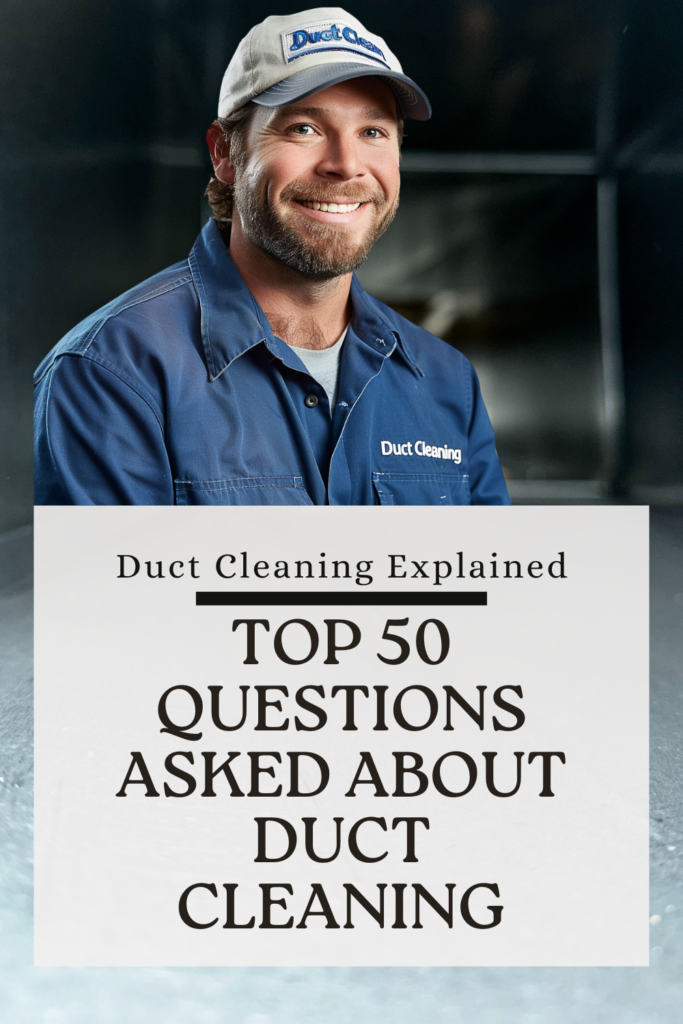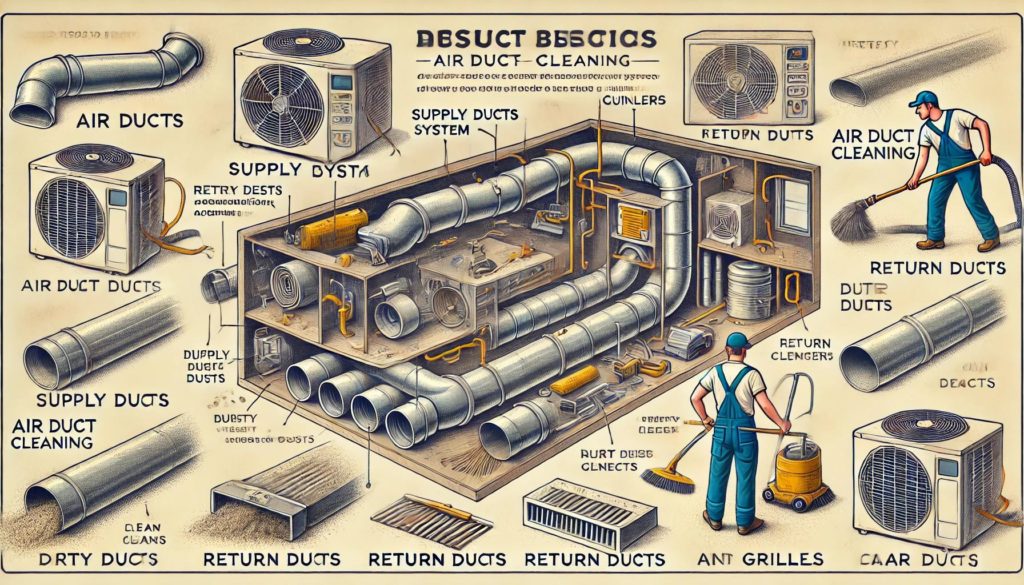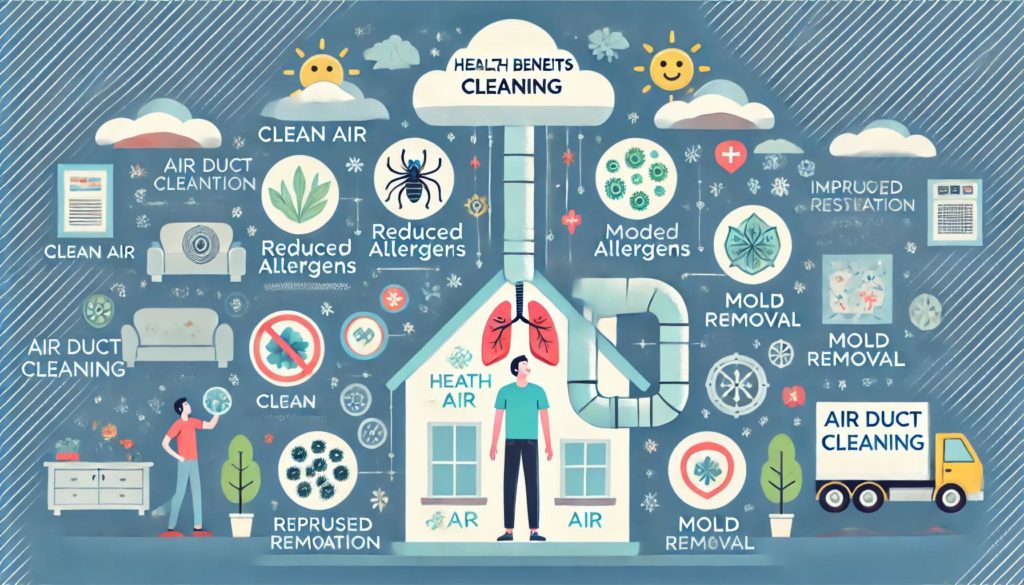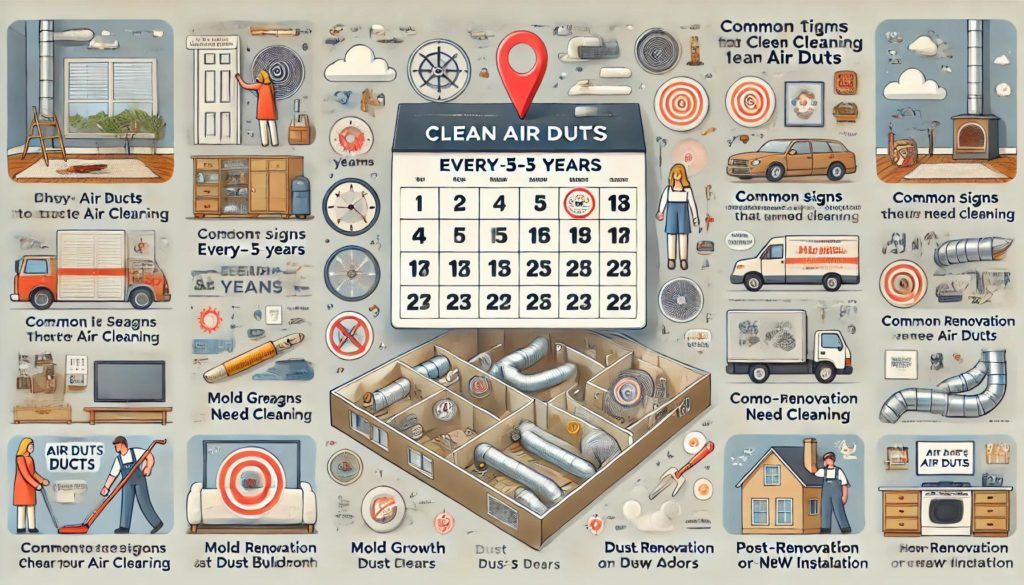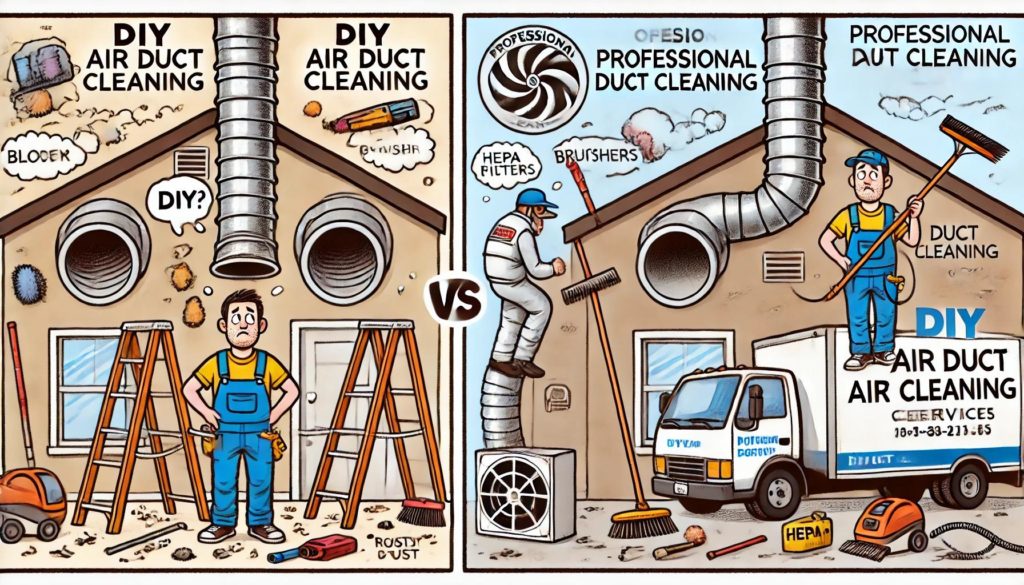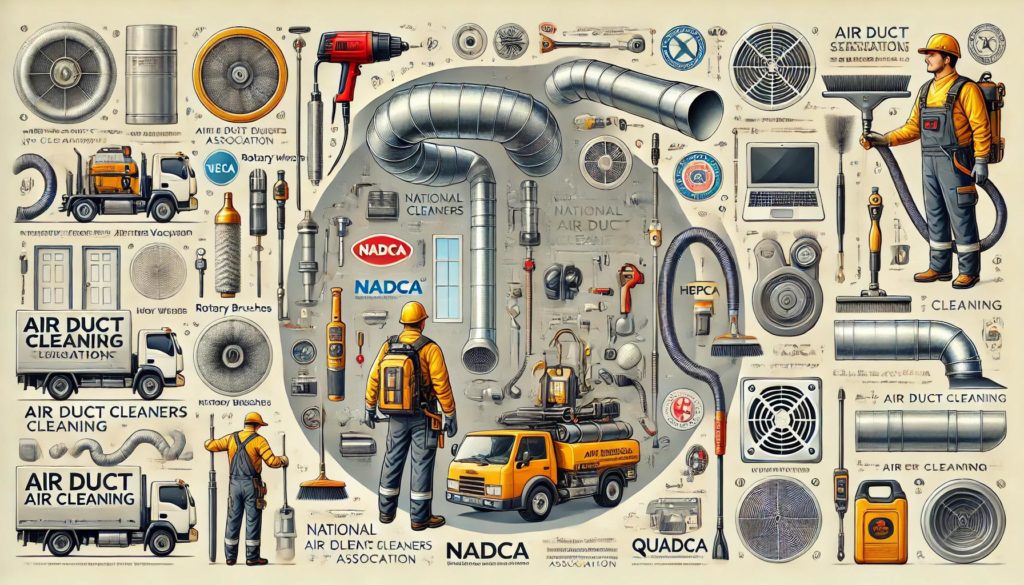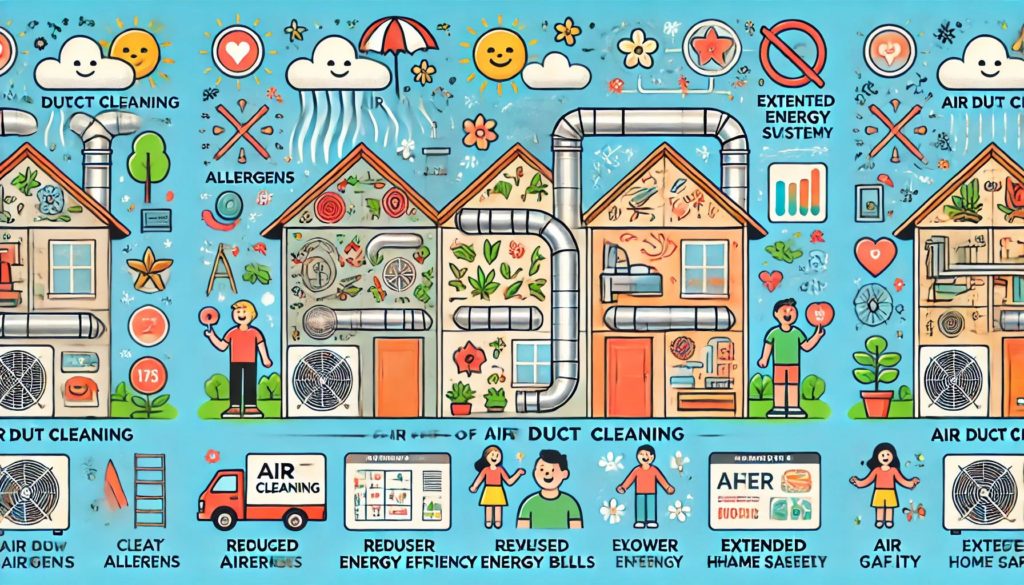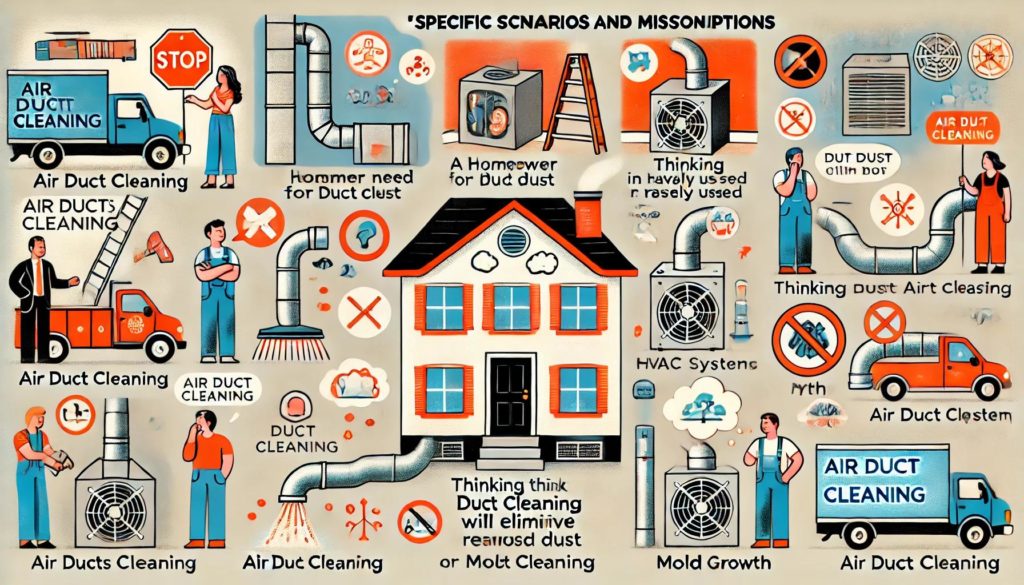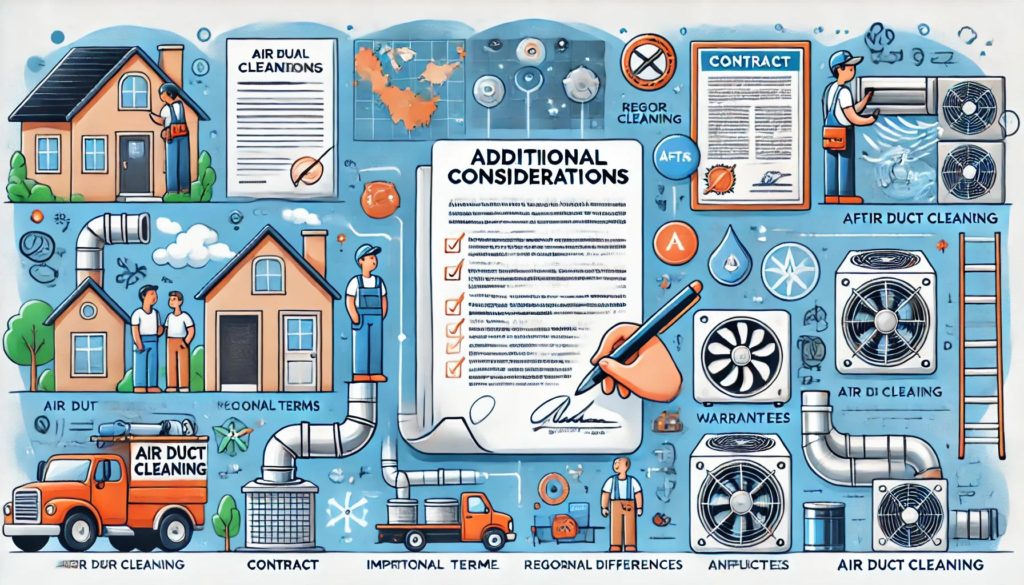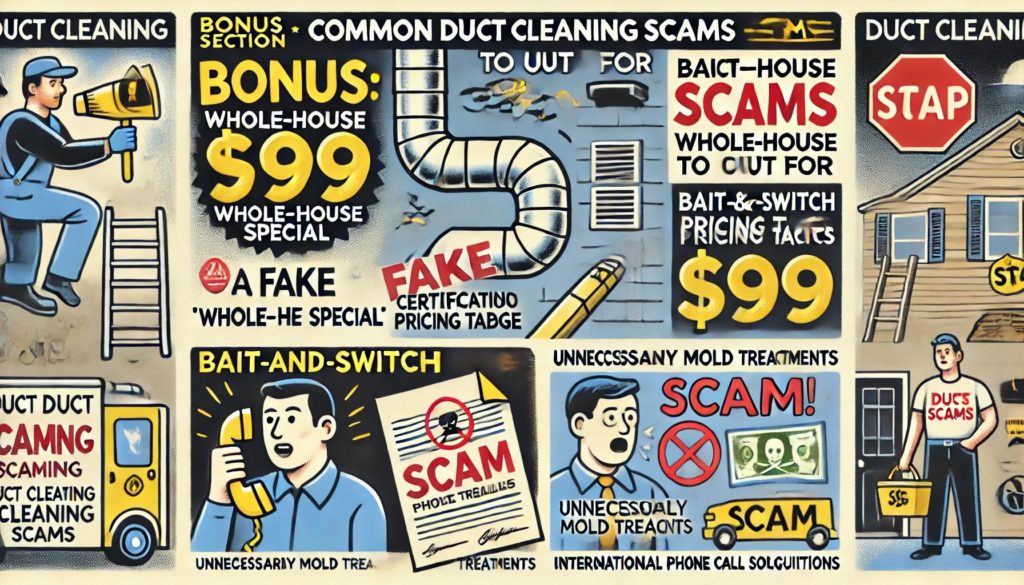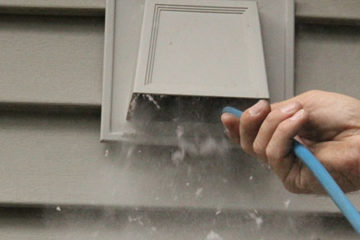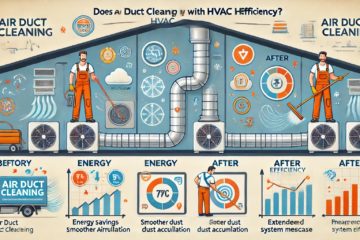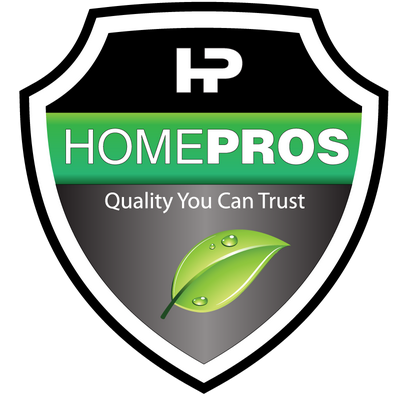The Ultimate Guide to Air Duct Cleaning: Answering the Top 50 Questions Asked About Duct Cleaning
Top 50 Questions Asked About Duct Cleaning – When it comes to maintaining a healthy and efficient home, air duct cleaning is a topic that often raises many questions. Whether you’re a new homeowner curious about the benefits, or someone dealing with allergies and looking for ways to improve indoor air quality, understanding the ins and outs of duct cleaning can make a significant difference.
Air ducts play a crucial role in circulating air throughout your home, and over time, they can accumulate dust, debris, allergens, and even mould. This buildup can affect not only the performance of your HVAC system but also the quality of the air you and your family breathe. Yet, many homeowners are unsure about how often ducts should be cleaned, the methods used, and whether it’s even necessary.
In this ultimate guide, we’ve compiled the top 50 questions people commonly ask about air duct cleaning. To help you navigate this topic with ease, we’ve grouped these questions into relevant categories, covering everything from the basics of air duct cleaning and its health benefits to practical considerations, DIY options, and professional standards.
Our goal at Home Pros Group is to provide you with comprehensive answers and insights, so you can make informed decisions about maintaining clean, efficient, and healthy air ducts in your home. Let’s dive in and address the most pressing questions homeowners have about air duct cleaning, starting with the basics.
Group 1: Basics of Air Duct Cleaning – Top 50 Questions Asked About Duct Cleaning
Air duct cleaning is an essential part of home maintenance that involves the thorough cleaning of the ducts within your HVAC system. These ducts serve as the lungs of your home, circulating air from your heating and cooling system into and out of every room. Over time, dust, debris, pet dander, mould, and other contaminants can accumulate inside these ducts, potentially affecting indoor air quality and the efficiency of your HVAC system.
Understanding the basics of air duct cleaning can help homeowners make informed decisions about when and how to clean their ducts. Generally, duct cleaning involves removing built-up dirt and debris from the ductwork to improve airflow and minimize the spread of allergens and pollutants. The cleaning process may vary depending on the specific needs of your home and the condition of your ducts.
Top 50 Questions Asked About Duct Cleaning – The frequency of cleaning depends on several factors, including the presence of pets, allergies, or recent renovations. Additionally, understanding the different methods of duct cleaning and what to look for in a service provider can help ensure that the job is done effectively and safely. In this section, we will explore the fundamental questions about air duct cleaning to provide a solid foundation for homeowners.
Air duct cleaning services involve the removal of dust, debris, mould, and other contaminants from your HVAC system’s ductwork. This is typically done using specialized equipment like high-powered vacuums, brushes, and blowers to clean all components of the system, including the supply and return ducts, registers, grilles, and diffusers.
Air ducts should generally be cleaned every 3 to 5 years. However, circumstances such as having pets, allergies, smokers in the home, or recent renovations may require more frequent cleaning to maintain optimal indoor air quality.
Air ducts accumulate dirt, dust, pet dander, mould spores, and other particles over time due to regular HVAC use. Contaminants are pulled into the system and recirculated through the ducts multiple times a day, leading to buildup that can affect air quality and system efficiency.
Air ducts are cleaned using methods such as source removal, which involves placing the system under negative pressure with a high-powered vacuum to dislodge and remove debris. Technicians may also use brushes, air whips, or other devices to clean the duct walls and other system components thoroughly.
The best method for cleaning air ducts is the source removal technique, which effectively removes debris and contaminants from the entire system. This method requires specialized equipment and should be performed by trained professionals to ensure safety and efficiency.
Group 2: Health and Safety Considerations
Air duct cleaning can have a significant impact on the health and safety of your home. When air ducts become clogged with dust, dirt, mould spores, and other contaminants, they can negatively affect the air quality inside your house. Poor indoor air quality is especially concerning for people with allergies, asthma, or other respiratory conditions, as these contaminants can exacerbate symptoms and reduce overall well-being.
Moreover, clean air ducts can help eliminate unpleasant odours caused by mould, mildew, pets, or tobacco smoke that might be trapped within the ductwork. While air duct cleaning is generally considered safe, it is essential to hire a reputable company that follows industry standards to avoid potential damage to your HVAC system.
By regularly cleaning your air ducts, you can reduce the risk of health problems associated with indoor air pollution, enhance your home’s overall comfort, and ensure the safety of your HVAC system. This section addresses the most common health and safety-related questions about air duct cleaning to help you understand its benefits, risks, and impact on your home environment. Top 50 Questions Asked About Duct Cleaning
Yes, cleaning air ducts can help remove dust, allergens, mould spores, and other contaminants, improving indoor air quality and reducing potential health issues such as allergies, asthma, and respiratory infections. Clean air ducts can also help prevent the spread of bacteria and viruses.
Air duct cleaning can significantly help reduce allergens like dust, pollen, pet dander, and mould spores in your home’s air. By removing these particles from the ductwork, the air circulating in your home becomes cleaner, which can alleviate allergy symptoms.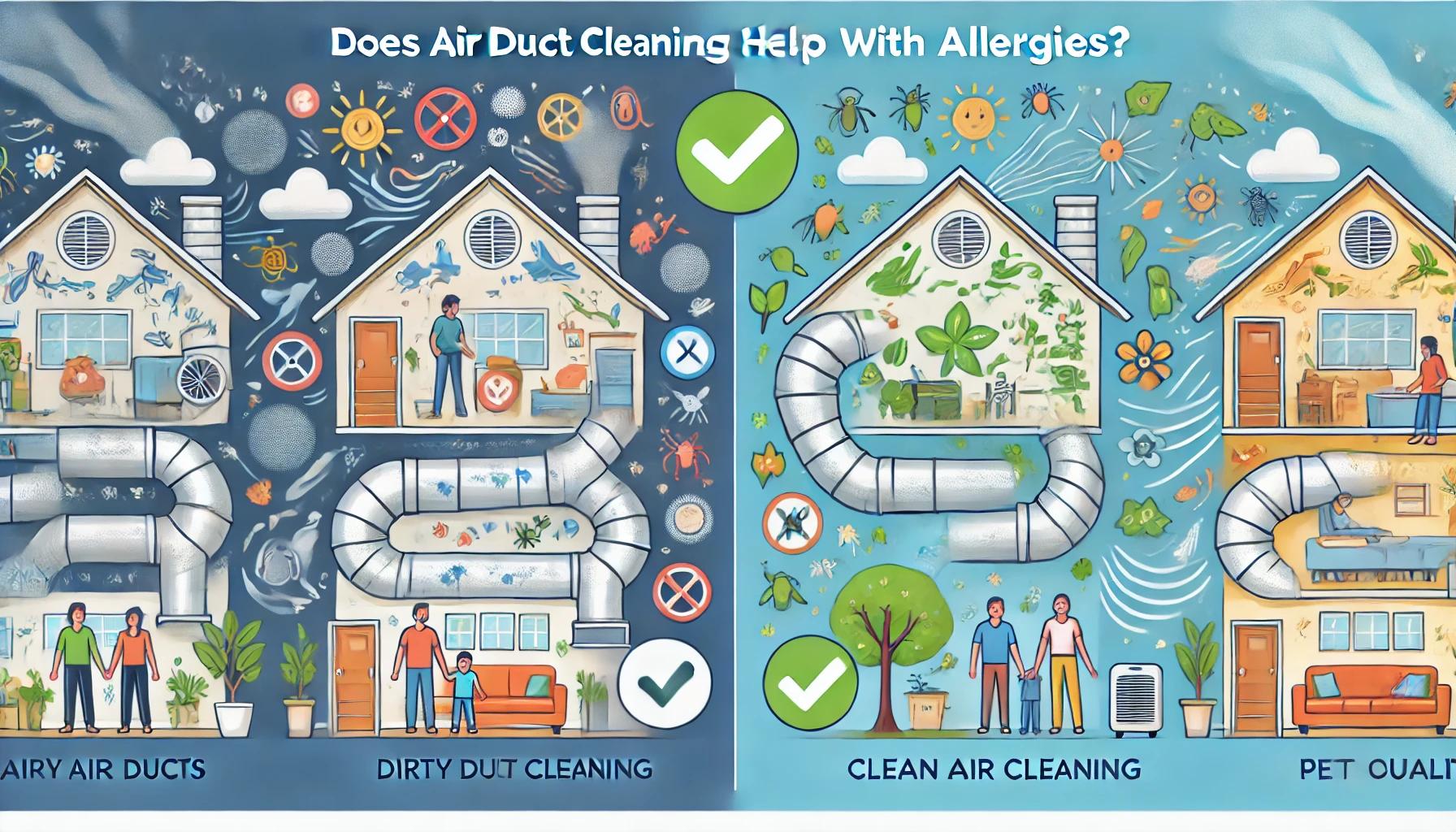
Air duct cleaning is safe when performed by trained professionals who use proper equipment and follow industry standards. However, improper cleaning techniques or the use of harsh chemicals can pose risks to your HVAC system and indoor air quality, so it’s crucial to choose a reputable company.
Common contaminants found in air ducts include dust, dirt, pollen, pet dander, mould spores, bacteria, and viruses. In some cases, larger debris such as leaves, pests, or rodent droppings may also be present, all of which can negatively impact indoor air quality.
Yes, air duct cleaning can help eliminate unpleasant odours caused by mould, mildew, tobacco smoke, cooking, or pets trapped in the ductwork. Removing these odour-causing particles from the ducts can lead to fresher-smelling air throughout your home.
Group 3: Costs, Time, and Practicalities – Top 50 Questions Asked About Duct Cleaning
Understanding the practical aspects of air duct cleaning, including the cost and time involved, is essential for homeowners considering this service. The cost of air duct cleaning can vary significantly based on factors such as the size of your home, the complexity of your HVAC system, and your location. On average, you can expect to pay between $300 to $500 for professional air duct cleaning, though some services may cost more or less depending on specific conditions.
In terms of time, a standard air duct cleaning for a typical home usually takes between 2 to 4 hours. However, this can vary based on the number of vents, the size of the ductwork, and the level of contamination. It’s important to remember that professional duct cleaning services aim to minimize disruption and mess while ensuring a thorough cleaning.
While there is an upfront cost, air duct cleaning can save money in the long run by improving the efficiency of your HVAC system, potentially lowering energy bills, and extending the system’s lifespan. In this section, we address common questions about the costs, time commitment, and practical aspects to help you decide if and when to clean your air ducts. Top 50 Questions Asked About Duct Cleaning
The cost of air duct cleaning typically ranges from $300 to $500, depending on factors such as the size of your home, the complexity of the duct system, and your location. Prices may vary based on the level of contamination and the specific services offered by different companies.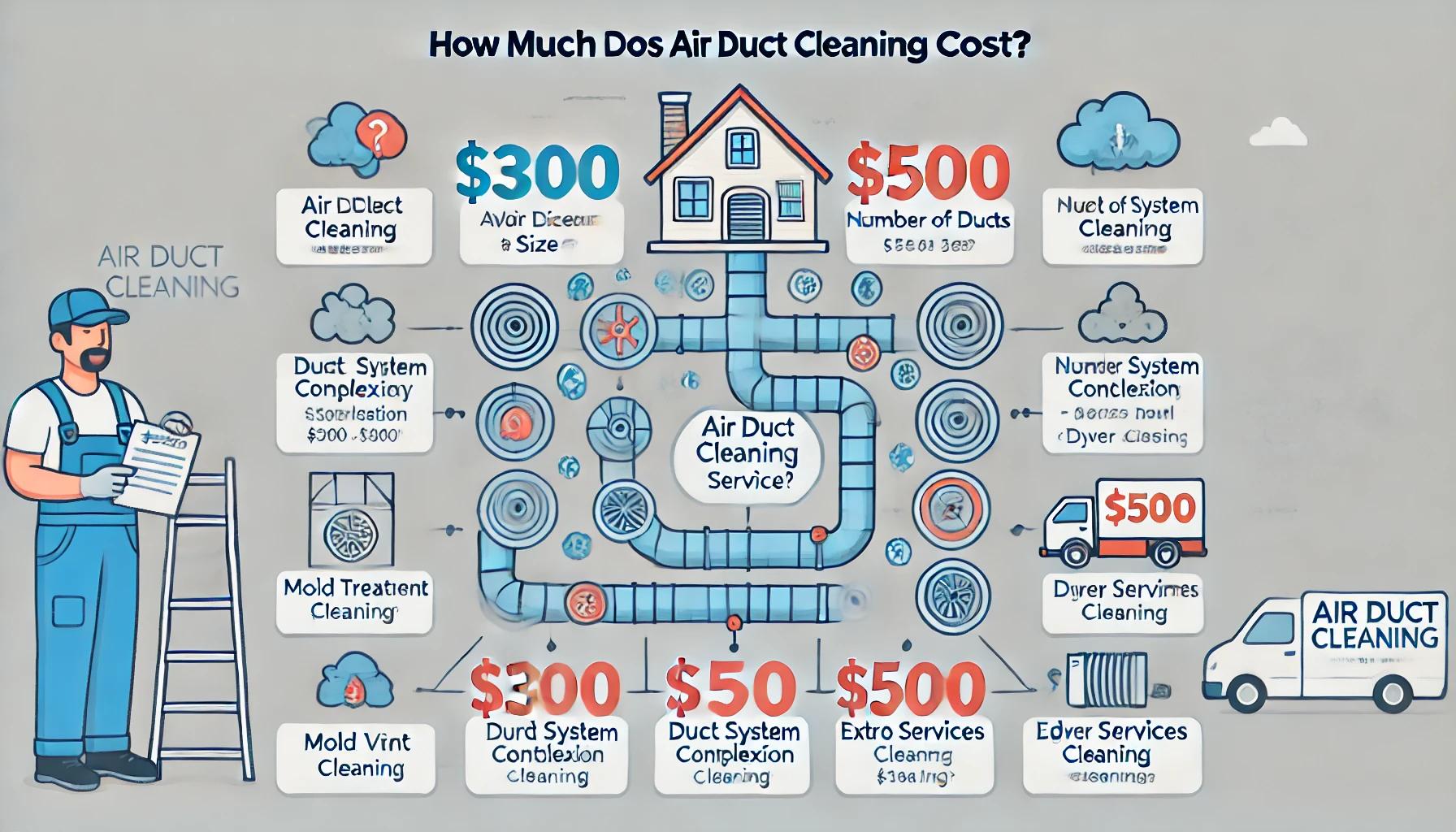
The duration of air duct cleaning depends on the size of your home and the extent of the contamination. On average, a professional air duct cleaning takes between 2 to 4 hours. However, larger homes or more complex systems may require additional time.
While air duct cleaning involves accessing various parts of the HVAC system, reputable companies use specialized equipment like high-powered vacuums and containment systems to minimize mess. Professional technicians take steps to ensure that debris and dust are contained, preventing any significant disruption to your home.
Yes, air duct cleaning can improve the efficiency of your HVAC system by removing debris that restricts airflow. This can reduce the workload on the system, leading to lower energy consumption and potentially reducing energy bills over time.
Typically, air duct cleaning and dryer vent cleaning are separate services. While some companies may offer both services as a package, it’s important to confirm with the service provider whether dryer vent cleaning is included in the air duct cleaning service.
Group 4: When and Why to Clean Air Ducts
Knowing when and why to clean your air ducts is crucial to maintaining a healthy and efficient home environment. Over time, air ducts can accumulate dust, debris, mould spores, and other contaminants, which can reduce HVAC efficiency and affect indoor air quality. But how do you know when it’s the right time to schedule a cleaning?
Several signs may indicate that your air ducts need cleanings, such as visible mould growth, excessive dust around your vents, or unusual odours coming from your HVAC system. Homeowners should also consider duct cleaning after significant events like home renovations or water damage, as these situations can lead to increased dust or moisture in the ductwork.
While regular air duct cleaning is generally recommended every 3 to 5 years, some homes may require more frequent attention, especially if there are pets, smokers, or allergy sufferers in the household. Ignoring the need for air duct cleaning can result in a decline in air quality, increased allergens, and even potential damage to your HVAC system. In this section, we explore the key reasons and situations that might warrant a more immediate cleaning. Top 50 Questions Asked About Duct Cleaning
You may need to clean your air ducts if you notice visible mould growth inside the ducts, an increase in dust or debris around your vents, a musty odour coming from the HVAC system, or worsening allergy symptoms among household members.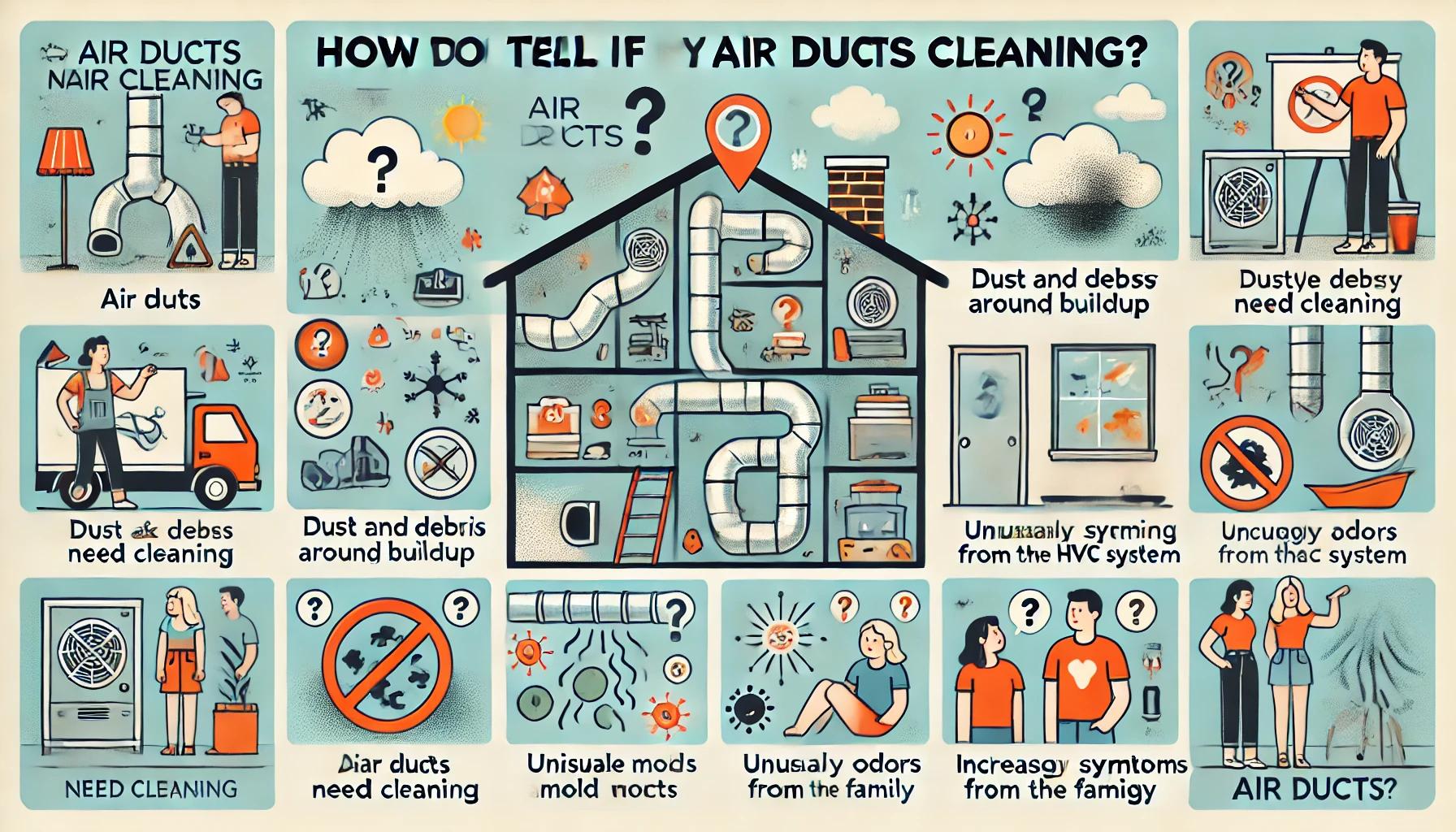
Signs that your air ducts need cleaning include visible dust and debris blowing out from vents, mould or mildew growth, a persistent musty smell, inconsistent airflow in different rooms, and an unexplained spike in energy bills due to reduced HVAC efficiency.
Yes, air ducts should be cleaned after significant home renovations. Construction activities can generate a considerable amount of dust and debris, which can easily enter and accumulate in your ductwork, impacting air quality and HVAC performance.
If you have a new HVAC system but have not cleaned your existing ductwork, it’s a good idea to clean the ducts to prevent old dust, debris, or contaminants from circulating through the new system. Clean ducts can help maximize the efficiency and lifespan of your new HVAC unit.
Neglecting air duct cleaning can lead to a buildup of dust, allergens, and contaminants, reducing HVAC efficiency, increasing energy bills, and worsening indoor air quality. Over time, it can also cause health problems for occupants, particularly those with allergies or respiratory conditions.
Group 5: DIY vs. Professional Cleaning
When it comes to air duct cleaning, homeowners often face a choice between doing it themselves (DIY) or hiring a professional service. While a DIY approach may seem cost-effective, it comes with certain challenges and risks. Cleaning air ducts requires specialized equipment, such as high-powered vacuums and brushes, that are not typically available to the average homeowner. Attempting to clean air ducts without the proper tools and knowledge can lead to incomplete cleaning, damage to the ducts, or even the release of more contaminants into your home.
On the other hand, hiring a professional air duct cleaning service ensures that the job is done thoroughly and safely. Professional companies have trained technicians who follow industry standards, like those set by the National Air Duct Cleaners Association (NADCA). They also use advanced equipment to reach all parts of the duct system and effectively remove contaminants.
If you decide to hire a professional, it’s important to choose a reputable company. Look for certifications, positive customer reviews, and transparent pricing. In this section, we explore the pros and cons of DIY versus professional air duct cleaning and provide guidance on selecting a trustworthy service provider. Top 50 Questions Asked About Duct Cleaning
Yes, it is possible to clean your air ducts yourself, but it is not usually recommended. DIY cleaning often lacks the proper equipment and expertise needed to thoroughly clean the entire duct system, which could lead to incomplete cleaning and potential damage to the ducts.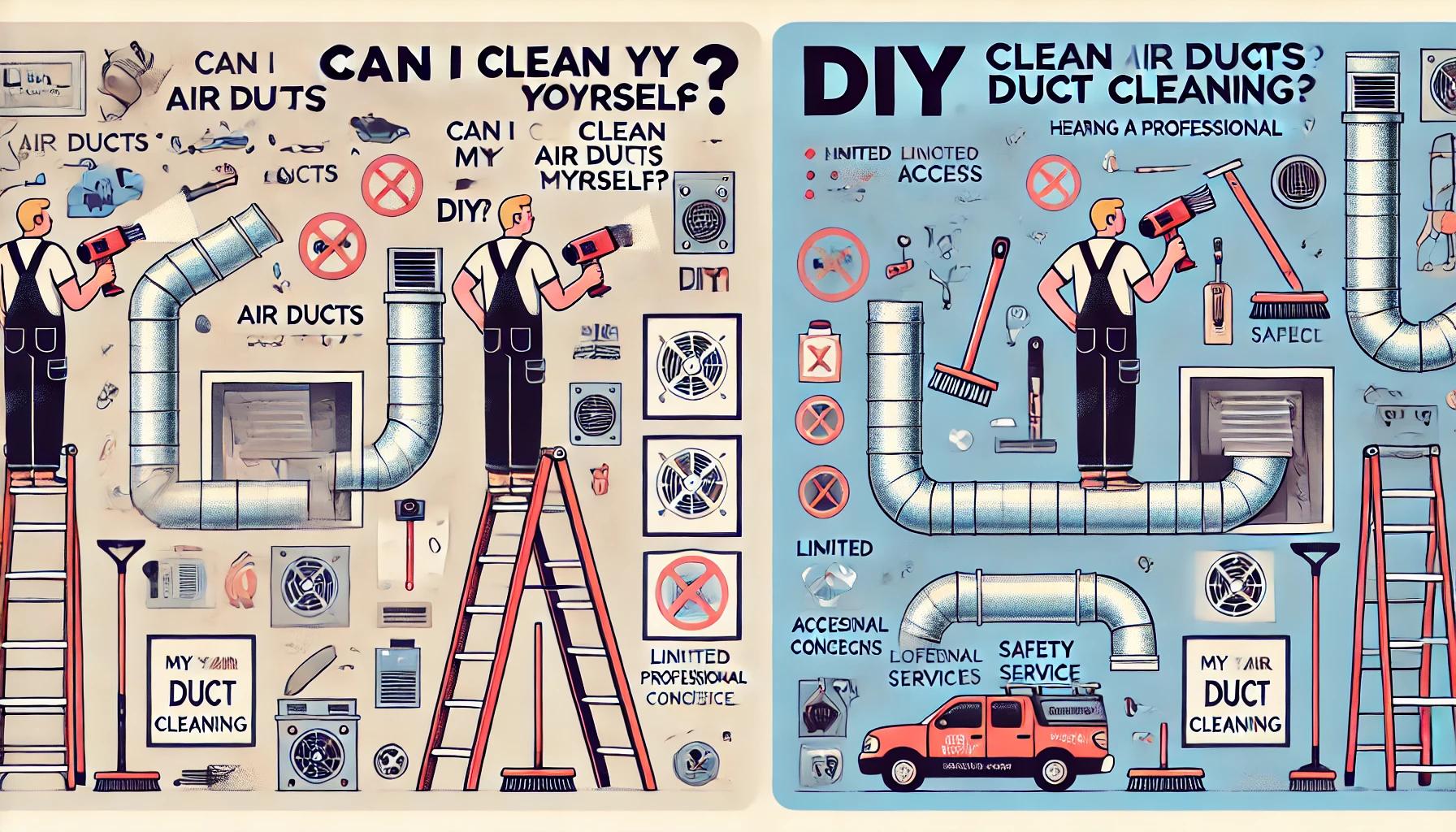
To prepare for air duct cleaning, ensure all vents are accessible, clear the area around the HVAC system, and remove any fragile items from the cleaning zone. You may also want to confirm with your service provider if there are any specific preparations they recommend.
A reputable air duct cleaning company should have NADCA or QUADCA certification, which ensures they adhere to industry standards and best practices. Other certifications, such as those from the Institute of Inspection, Cleaning, and Restoration Certification (IICRC), can also indicate professionalism and expertise.
Start by searching for local companies online, checking their reviews, and visiting their websites to learn more about their services. Ask for recommendations from friends or neighbours and request quotes from multiple companies to compare services and pricing.
Group 6: Equipment, Methods, and Industry Standards
Air duct cleaning involves more than just removing visible dust from your ducts—it requires specialized equipment, methods, and adherence to industry standards to ensure thorough and safe cleaning. Professional air duct cleaners use a range of tools, including high-powered vacuums, brushes, air whips, and agitation devices, to effectively remove debris and contaminants from all parts of the duct system. One of the most trusted methods is source removal, which uses a negative-pressure vacuum system to extract particles directly from the ducts.
Choosing a cleaning company that follows industry standards, like those set by the National Air Duct Cleaners Association (NADCA), is essential for ensuring a quality job. NADCA-certified companies adhere to strict guidelines and best practices, including the use of equipment that meets specific safety and effectiveness criteria.
In addition to regular cleaning, some companies may use antimicrobial chemicals to treat mould, bacteria, or other microbial contaminants. However, these treatments should only be used when necessary and must be EPA-approved for HVAC use to ensure safety. This section answers key questions about the equipment, methods, and standards involved in air duct cleaning, helping homeowners understand what to expect from a professional service. Top 50 Questions Asked About Duct Cleaning
Air duct cleaning requires specialized equipment such as high-powered vacuums, brushes, air whips, and rotary brushes. The most effective equipment includes negative pressure vacuums that remove debris from the ducts without releasing it back into the indoor environment.
NADCA, the National Air Duct Cleaners Association, is a trade association that sets standards for HVAC cleaning. Membership in NADCA signifies that a company adheres to industry best practices, uses appropriate equipment, and employs trained technicians, ensuring a high standard of service.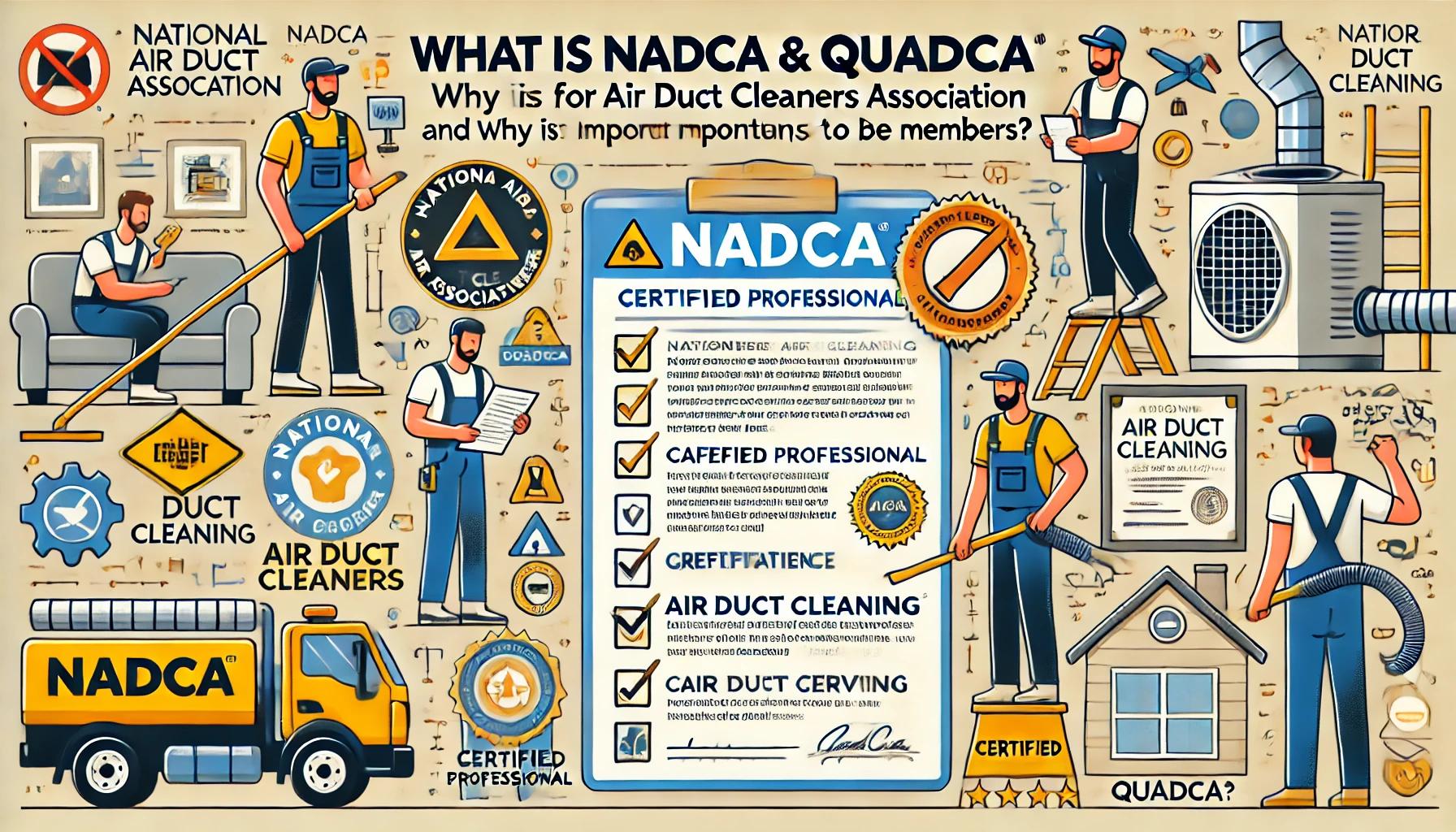
Antimicrobial chemicals are used to eliminate microbial contaminants like mould and bacteria within air ducts. However, they should only be applied when there is evidence of microbial growth, and they must be EPA-approved specifically for HVAC use to ensure safety and effectiveness.
Yes, the primary methods include source removal, which involves placing the system under negative pressure to remove debris, and mechanical agitation, which uses brushes or air whips to dislodge particles. Source removal is generally considered the most effective method.
Sanitizing air ducts is not always necessary. It may be recommended if there is microbial contamination, such as mould or bacteria, but it should only be done using EPA-approved sanitizers. Regular cleaning without chemicals is often sufficient to maintain clean air ducts.
Group 7: Effects on HVAC System and Home
Air duct cleaning has a significant impact on both your HVAC system’s performance and your home’s overall environment. Over time, dust, debris, and other contaminants can build up in your air ducts, causing your HVAC system to work harder than necessary. This added strain can reduce system efficiency, increase energy consumption, and ultimately lead to higher utility bills. By removing these contaminants, air duct cleaning helps restore optimal airflow, allowing your HVAC system to operate more efficiently and potentially extending its lifespan.
In addition to improving system performance, clean air ducts can enhance indoor air quality by reducing the circulation of allergens, dust, and other pollutants. This can be particularly beneficial for individuals with allergies or respiratory issues. However, it is essential to understand that improper duct cleaning methods could potentially damage your HVAC system. That’s why it’s crucial to hire professionals who use appropriate equipment and follow industry standards.
This section will answer common questions about how duct cleaning affects your HVAC system and home environment, highlighting the benefits and potential risks associated with this important maintenance task. Top 50 Questions Asked About Duct Cleaning
Yes, air duct cleaning can improve HVAC efficiency by removing dust and debris that restrict airflow. Clean ducts enable the system to distribute air more effectively, reducing the workload on the unit and potentially lowering energy bills.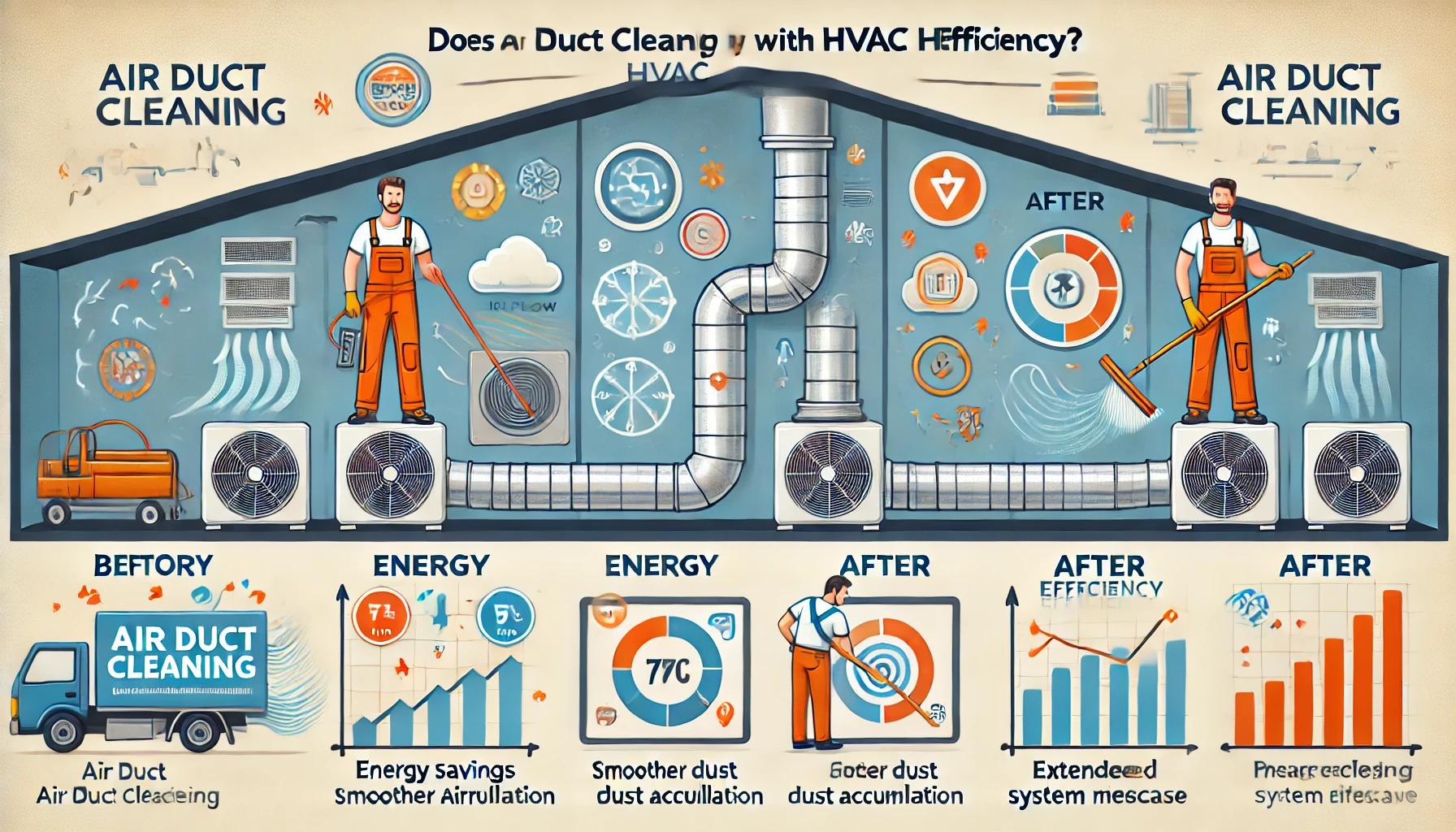
Air duct cleaning is generally safe when performed by trained professionals using the correct equipment. However, improper cleaning methods, such as using harsh chemicals or high-pressure tools, can damage ducts or other HVAC components. Always choose a certified and reputable company.
Air duct cleaning can significantly improve indoor air quality by removing accumulated dust, allergens, mould spores, and other contaminants from the ductwork. This helps reduce the spread of airborne pollutants, benefiting those with allergies, asthma, or respiratory conditions.
Clean air ducts reduce the risk of mould growth and the circulation of harmful particles that can impact respiratory health. Additionally, it can prevent potential fire hazards caused by the buildup of dust and debris near the furnace or heating elements.
Uncleaned air ducts can lead to reduced HVAC efficiency, higher energy costs, poor indoor air quality, and potential health issues due to allergens, dust, or mould spores. In extreme cases, excessive buildup can pose a fire risk or cause HVAC system failure.
Group 8: Specific Scenarios and Misconceptions
Air duct cleaning often comes with a lot of misconceptions and unique scenarios that can make deciding whether or not to clean your ducts more complicated. For example, some people wonder whether air duct cleaning is necessary if they rarely use their HVAC system or if different methods are required for residential versus commercial ductwork. Others worry about potential risks or believe that duct cleaning can solve every air quality problem, which is not always the case.
Additionally, some homeowners may not realize that duct cleaning isn’t always needed regularly unless specific circumstances are present, such as visible mould growth, rodent infestations, or significant dust buildup. Understanding these scenarios helps in making a well-informed decision about whether or not to invest in air duct cleaning services.
This section addresses these special cases and debunks common myths surrounding air duct cleaning. It will help clarify when duct cleaning is genuinely beneficial and when it may not be necessary, providing practical guidance to homeowners who are uncertain about whether this service is right for them. Top 50 Questions Asked About Duct Cleaning
While air duct cleaning is generally safe, potential risks exist if the service is performed improperly. These include damage to the ductwork, the release of dust and debris into the home, and exposure to harmful chemicals. Hiring a certified professional can mitigate these risks.
If you rarely use your HVAC system, you may not need frequent air duct cleaning. However, if the system is still used occasionally or if there are signs of contamination (like mould or dust buildup), cleaning may still be beneficial to maintain indoor air quality.
Yes, while the fundamental principles of duct cleaning are similar, commercial duct systems are often larger and more complex than residential ones. They may require specialized equipment and methods to handle larger volumes and different types of contaminants.
Common misconceptions include the belief that air duct cleaning will completely eliminate dust in the home, prevent mould growth permanently, or that it must be done annually. In reality, the need for cleaning depends on various factors, and results can vary based on the condition of the ductwork and HVAC usage.
While air duct cleaning can remove existing mould spores, it does not prevent future mould growth if the conditions (such as moisture) that caused the mould initially are not addressed. Proper system maintenance and moisture control are essential to prevent mould recurrence.
Group 9: Maintenance and Follow-Up
Maintaining clean air ducts is essential for ensuring the longevity of your HVAC system and maintaining good indoor air quality. While professional air duct cleaning can remove accumulated dust, debris, and contaminants, regular maintenance between cleanings is also necessary to prevent the buildup of pollutants. Simple actions, like replacing your HVAC filters regularly and keeping vents clean, can help keep your ducts in better condition for longer.
When you decide to hire a professional air duct cleaning service, it’s important to know what to expect. A reputable company will provide a detailed explanation of their cleaning process, list what is included in their service, and offer a clear and fair price. Additionally, checking for certifications and customer reviews can help ensure that you’re hiring a trustworthy provider.
Understanding what is involved in maintaining clean air ducts, what services are typically included in professional cleaning, and how to select a reliable company can help you keep your home safe and your HVAC system efficient. This section answers some of the most common questions regarding maintenance and follow-up for air duct cleaning. Top 50 Questions Asked About Duct Cleaning
Regularly replace HVAC filters, keep vents and registers clean, and ensure proper humidity levels in your home to prevent mould growth. Also, schedule routine inspections of your HVAC system to catch any issues early.
A professional air duct cleaning typically includes the cleaning of all supply and return ducts, registers, grilles, diffusers, and other components such as the furnace fan, coils, and drain pan. Some services may also include the application of antimicrobial treatments if needed.
Look for certifications, such as NADCA membership, positive customer reviews, and a transparent explanation of their process and pricing. Ask for references and ensure they provide a written estimate and guarantee their work.
Air ducts do not need to be cleaned regularly unless there are specific reasons, such as mould growth, rodent infestation, or excessive dust and debris. Generally, cleaning every 3 to 5 years is sufficient, but this can vary based on environmental conditions and system usage.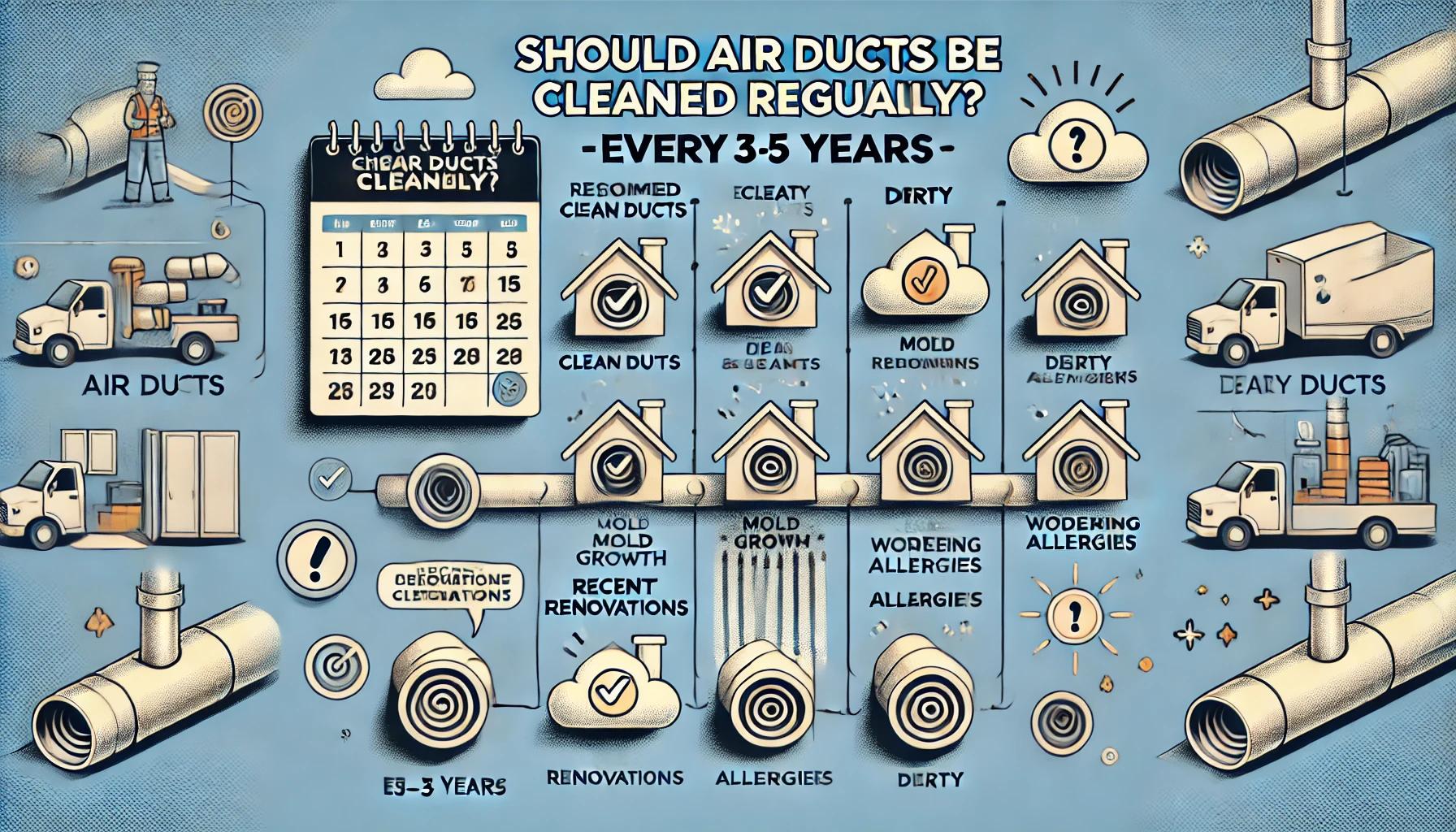
Air duct cleaning is typically considered a maintenance expense and is not covered by most homeowners’ insurance policies. However, if duct cleaning is needed due to damage from a covered peril, like a fire or flood, it may be covered. It’s best to check with your insurance provider.
Group 10: Additional Considerations
When deciding on air duct cleaning, several additional considerations can influence your decision. These factors might include warranties or guarantees provided by the cleaning service, what should be included in a contract, and how regional differences might affect pricing and service availability. For instance, homes in regions with higher levels of dust or pollen may require more frequent duct cleaning, whereas homes in less dusty areas might not need it as often.
Understanding the role of air duct cleaning in managing indoor air quality is also crucial. While duct cleaning can improve air quality by removing contaminants, it should be part of a broader strategy that includes regular HVAC maintenance, using high-quality air filters, and controlling humidity levels.
Finally, it’s essential to know what parts of the HVAC system are inspected or cleaned during air duct cleaning. Not all companies include the inspection of HVAC components like fans or coils, which are integral to the system’s efficiency and safety. This section addresses these considerations to help you make the most informed decision about air duct cleaning services. Top 50 Questions Asked About Duct Cleaning
Many reputable air duct cleaning companies offer warranties or satisfaction guarantees to ensure customer confidence in their services. It’s important to ask about any guarantees provided before hiring a company to understand what is covered if you are not satisfied with the work.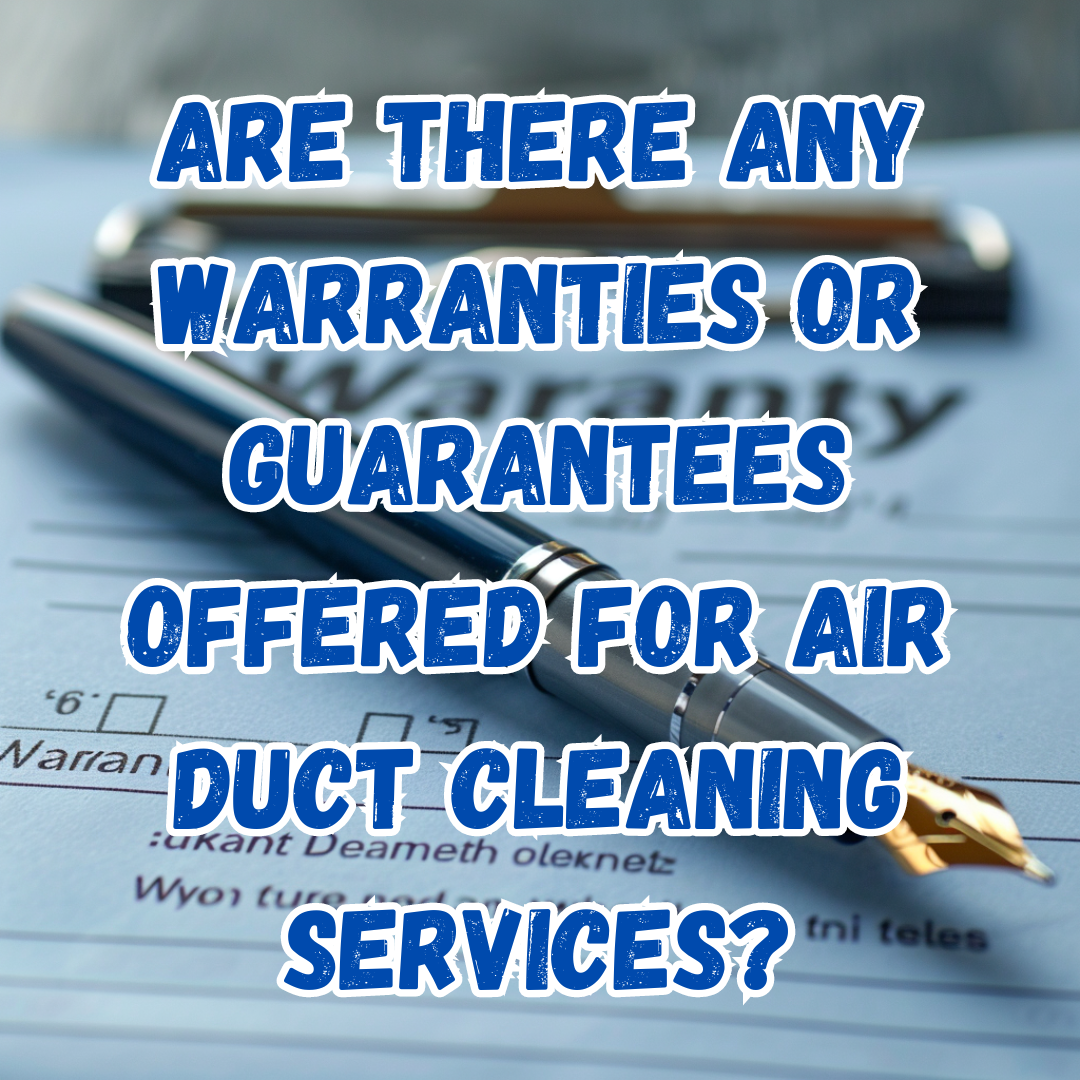
A good air duct cleaning contract should include a detailed description of the services to be provided, the total cost, the estimated time required, any guarantees or warranties, and the company’s certifications. Ensure there is clarity on what parts of the HVAC system will be cleaned.
Regional differences, such as the local climate, levels of dust or pollen, and common HVAC systems, can impact the frequency and cost of duct cleaning. For example, homes in dusty or humid areas may require more frequent cleaning to prevent mould and dust buildup.
Air duct cleaning plays a role in maintaining indoor air quality by removing accumulated dust, allergens, and contaminants from the ductwork. However, it should be combined with other measures like regular filter changes, humidity control, and proper ventilation to ensure the best results.
Not all air duct cleaning services include inspecting or cleaning HVAC components such as fans, coils, or heat exchangers. It’s important to clarify with the service provider which parts of the HVAC system are included in the service to ensure comprehensive cleaning and maintenance.
Bonus Section: Common Duct Cleaning Scams to Watch Out For
While professional air duct cleaning can improve indoor air quality and HVAC efficiency, there are also some common scams that homeowners need to be aware of. These scams often involve false advertising, hidden fees, or subpar services that can leave your ducts dirtier than before. Knowing how to identify these scams will help you avoid wasting money and ensure you hire a reputable service provider.
One of the most common scams is the “$99 whole-house special,” where a company advertises a very low price but then upsells additional services or claims your ducts need expensive mould treatments or repairs. Another scam involves using fake certification logos or credentials to appear trustworthy. Some companies may also employ bait-and-switch tactics, where they quote a low price over the phone but charge much more once on-site.
Additionally, beware of companies that refuse to provide a written estimate or contract before starting work. Others may use high-pressure sales tactics to coerce you into unnecessary services. By being vigilant and researching companies thoroughly, you can avoid falling victim to these scams. In this bonus section, we highlight five common duct cleaning scams to help you protect yourself and make informed decisions. Top 50 Questions Asked About Duct Cleaning
This scam offers a duct cleaning service for an extremely low price, such as $99, only to add extra charges for each vent, additional treatments, or necessary “repairs” once they arrive. The final bill often ends up much higher than the initial quote.
Some companies use fake certifications or logos to appear credible. Always verify certifications, such as NADCA membership, directly with the certifying organization to ensure the company is truly qualified.
In this scam, a company quotes a low price over the phone but charges significantly more upon arrival, citing extra services or unanticipated complications. Always request a written estimate that includes all potential costs before the work begins.
Some scammers claim to find mould in your air ducts and insist on costly mould treatments or remediation services that are not needed. If mould is suspected, ask for proof and consider a second opinion from a reputable mould remediation specialist.
Companies using high-pressure tactics might try to scare you into immediate action by exaggerating the condition of your ducts or suggesting health risks. A reputable company will provide clear information and allow you time to make an informed decision.
You may receive unsolicited phone calls from call centers located in other countries offering duct cleaning services. These calls are often made by third-party marketers who sell your information to local companies, potentially leading to subpar services or further scams. It’s best to ignore such calls and seek out reputable local providers directly.
Closing: The Ultimate Guide to Air Duct Cleaning: Answering the Top 50 Questions Homeowners Ask
Maintaining clean air ducts is a critical aspect of home care that directly impacts both your indoor air quality and the efficiency of your HVAC system. As we’ve discussed throughout “The Ultimate Guide to Air Duct Cleaning: Answering the Top 50 Questions Homeowners Ask,” understanding the basics of duct cleaning, its benefits, the costs involved, and how to avoid scams can empower you to make informed decisions.
From recognizing when your ducts need cleaning to selecting a reputable service provider, this guide provides a comprehensive overview of everything you need to know. Regular maintenance, paired with professional cleaning as needed, can help keep your home safe, comfortable, and energy-efficient.
Remember, whether you’re dealing with allergy issues, seeking to lower energy bills, or simply aiming to maintain a clean living environment, duct cleaning plays a vital role. By staying informed and vigilant, you can ensure that your duct cleaning service is both effective and reliable, keeping your home healthy and your HVAC system running smoothly for years to come.
Thank you from Home Pros Group for reading, and we hope this guide has answered your questions and provided valuable insights into the world of air duct cleaning. Feel free to refer back to this resource whenever you need guidance on maintaining a clean and efficient home environment!
